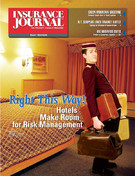High school and middle school students overwhelmingly say their parents are or will be the biggest influence on how they drive, but the practices many teens say they are emulating represent some of the most risky driving behaviors, according to the 2004 Liberty Mutual/Students Against Destructive Decisions (SADD) Teen Driving Study.
Nearly 60 percent of high school students say their parents are the biggest influence on their driving, and 69 percent of middle school students say parents will be the biggest influence when they do drive, according to the study.
“So when we engage in unsafe driving behaviors, it’s no wonder they are inheriting our bad habits behind the wheel,” commented Liberty Mutual Executive Vice President Paul Condrin.
Almost two-thirds (62 percent) of high school teens surveyed by Liberty Mutual and SADD say their parents talk on a cell phone while driving. Almost half, 48 percent, say their parents speed, and 31 percent say their parents don’t wear a safety belt.
Not surprisingly, given the survey’s finding that many young drivers are influenced by their parents driving habits, teens say they now follow, or expect to follow, these same practices in roughly the same percentages when they become drivers:
• Sixty-two percent of high school drivers say they talk on a cell phone while driving, and approximately half of high school teens who do not yet drive (52 percent) and middle school students (47 percent) expect
they will engage in this behavior when they begin driving.
• Sixty-seven percent of high school drivers say they speed. Interestingly, most high school teens (65 percent) who do not yet drive and middle school students (79 percent) say they would not speed once they got their license.
•Thirty-three percent of high school drivers say they do not wear their safety belt while driving. High school students who do not yet drive (28 percent) and middle school students (20 percent) are less likely to believe they will drive while not wearing a safety belt.
“It is critically important that parents set the example they wish their children to follow. Parents should not be afraid to establish expectations for their young drivers, discuss those expectations frequently, and ensure they are being met,” said Stephen Wallace, SADD chairman.
“Five years of Liberty Mutual and SADD research repeatedly shows that teens who have regular communication with their parents about expected behaviors are less likely to make destructive decisions.”
Parental influence on teen drivers may help explain a clear disconnect between how teens view themselves as drivers and their actual driving habits.
Nearly nine out of 10 teens (89 percent) describe themselves as safe drivers. Yet many reportedly engage in risky behaviors that often lead to crashes, including speeding, neglecting to use safety belts, and talking on a cell phone.
What’s more, many teens don’t view these behaviors as dangerous, again suggesting that they believe they are safe because their parents drive the same way:
• Twenty-seven percent of all high school students and 33 percent of
middle school students think speeding is safe.
• Twenty-five percent all high school students and 29 percent of middle school students say driving without a safety belt is safe.
• Twenty-four percent of high school students and 32 percent of middle school students say talking on a cell phone while driving is safe.
“The inability among teens to appreciate how unsafe their common driving behaviors are is alarming, yet not surprising, given the fact that parents and other influencing adults exhibit the same dangerous habits,” said Kathryn Swanson, chair of the Governors Highway Safety Association.
Topics Personal Auto Education
Was this article valuable?
Here are more articles you may enjoy.


 Viewpoint: Deepfake Fraud Is On the Rise. Here’s How Insurers Can Respond
Viewpoint: Deepfake Fraud Is On the Rise. Here’s How Insurers Can Respond  Hard Market Conditions Expected to Ease in 2025 as Claims Inflation Softens: Swiss Re
Hard Market Conditions Expected to Ease in 2025 as Claims Inflation Softens: Swiss Re  Man Admits to Tracking Drivers, Programming Keys, Stealing and Reselling Vehicles
Man Admits to Tracking Drivers, Programming Keys, Stealing and Reselling Vehicles  Travelers Reverses Q2 Income Loss, Narrows Underwriting Loss
Travelers Reverses Q2 Income Loss, Narrows Underwriting Loss 


